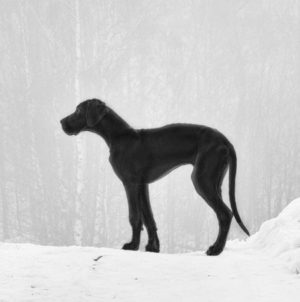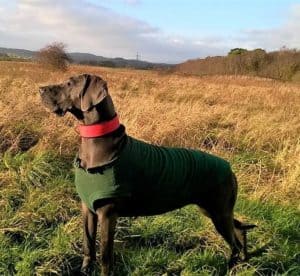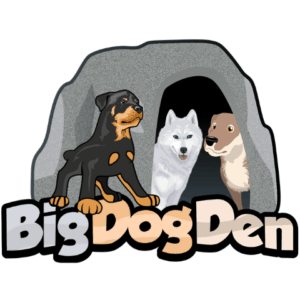Without a doubt, your Great Dane dog is going to grow to be massive in stature! During this rather rapid growth process, there will be times when your dog seems out of proportion. Gawky, even. It’s common for an owner of this delightful breed to look at their dog at some point in his (or her) growth cycle and wonder…
“Should Great Danes be skinny?” Your Great Dane should not be skinny, but should definitely be lean. But, isn’t lean skinny? Find out the difference.
If the answer immediately made you curious about the differences between skinny and lean, you’ve landed in the right place to find out. Welcome to the Big Dog Den, I’m glad you’re here! In this article, you’ll discover:
- The Differences Between Skinny and Lean
- The Healthy Weight Ranges for Great Dane Dogs
- How Much Great Danes Eat
- How Skinny is too Skinny for Your Great Dane
- Whether or Not Great Danes Can Become Obese
- How to Keep Your Great Dane Healthy and Fit
Your time is valuable to me, so to find you the most accurate and up-to-date information, I went straight to the experts in all things “Great Dane”. This includes, but is not limited to, the American Kennel Club (AKC) the American Veterinary Medical Association (AVMA) and the Great Dane Club of America (GDCA). Everything I learned from them is right here for you, in one convenient place!
There’s a lot of information to glean from, so let’s get started!
The Difference Between Skinny and Lean
Most people use the words skinny and lean interchangeably, but in reality, the words differ slightly in meaning. Skinny implies a lack. Lean implies a proper balance of weight in proportion to body size. When it comes to your Great Dane dog, lean is your goal.
A lean Great Dane has no excess body fat, and his (or her) last rib bone is slightly visible when the dog is standing. If every rib bone on your dog is protruding (as well as the hip bones) the dog is considered skinny and should be examined by a veterinarian to rule out any potential medical issues. A worm infestation, food allergy, or even certain cancers can cause a dog to not gain weight properly.

How Much Should a Great Dane Weigh?
One of the reasons it’s difficult to determine if a Great Dane weighs what it should is that the “normal” range varies greatly. Take a look:
- Puppies at 3 Months: 25-45 Pounds (11-20kg)
- Puppies at 6 Months: 65-100 Pounds (29-45kg)
- Adult Female: 99-130 Pounds (45-59kg)
- Adult Male: 120-200 Pounds (54-90kg)
That’s quite a span in “normal” isn’t it?!? Do note that female Great Danes will fall in the lower end of any weight ranges and males toward the higher end. Your dog’s veterinarian will tell you for sure what your Great Dane should weigh, once he (or she) has taken into account all the factors regarding the specific dog being examined.
If your Great Dane’s weight falls within the healthy ranges listed above, there is usually little need for concern. However, if your dog’s weight dips below the healthy range, please schedule a veterinary exam!
How Much do Great Danes Eat?
Here are the daily recommendations for feeding your Great Dane (according to age). These are general guidelines, and your dog may eat slightly more or slightly less. Only excessively more or less would indicate an issue. Please note, females eat at the lower end of the range as a general rule of thumb.
Your Great Dane Should Eat About:
- From 3-6 Months of Age: 3-6 Cups Daily
- From 8-12 Months of Age: 5-10 Cups Daily
- From 1-2 Years Old (Adolescence): 8-15 Cups Daily
- From 2-6 Years Old (Adulthood): 6-10 Cups Daily
As you can see, there’s quite a leeway! You want to give your dog the amount in the above ranges that he (or she) will eat in about 15 minutes, and not be “asking” to be fed in the very next hour. If the bowl is consistently empty in 5 minutes, try increasing the amount by a half to a whole cup at a time. If there is food left in the bowl constantly, decrease the portions by about the same amount that is left over.
When your dog is eating the right amount of food, he (or she) with thrive, have plenty of energy, rest well at night, and not be prone to destructive behaviors.
***The above feeding guideline is an excerpt from “Is it Normal for a Great Dane to Always be Hungry?” found right here in the Big Dog Den. I highly recommend you check it out to discover why your Great Dane always seems hungry, and what you can do to help.
How Skinny is too Skinny for a Great Dane?

As you learned above, the healthy weight range for a Great Dane dog varies greatly. It can make it harder to determine if your dog weighs what’s right for him (or her). If your dog’s weight falls within the healthy range, yet you are seeing protruding bones (hips, ribs, or spine), you can be assured that for your specific furry companion, the weight should fall more toward the higher end of the range.
In addition to protruding bones “announcing” a dog is too skinny, your Great Dane’s abdomen can offer clues. If your dog is at a healthy weight, his (or her) abdomen will slope gradually upward to the ribcage. The abdomen of a dog who is too skinny will appear “tucked away” from the ribcage.
Even in adolescence, when it’s completely normal for your Great Dane to seem ill-proportioned because of his (or her) long gawky legs, protruding bones and a “tucked” appearance to the abdomen are red flags you should closely monitor. By adulthood, a Great Dane carrying a healthy weight will have an overall muscular appearance. He (or she) should look solid rather than bony.
Lastly, lethargy can be added to the list of symptoms that may indicate your Great Dane is too skinny. You own a high-energy dog breed! Once a medical cause has been ruled out, lethargy can indicate your dog isn’t getting the nutrition he (or she) needs either because of poor-quality food, or not enough food. Make sure you’re feeding your Great Dane a food formulated to support his (or her) massive size! And don’t follow the serving sizes recommended on the package. Rather, adjust the serving size to fit your dog’s specific needs and proper growth.
Discover how dog food formulas differ by following this link. You’ll be redirected to my article that reveals all you need to know!
It’s recommended you divide your Great Dane’s daily food allotment into at least two servings. Three would be better! The reason for this is that your dog’s hormone and energy levels will be more balanced throughout the day than they would be with only one daily feeding. A more balanced dog is going to feel better overall, and will not seek out so many snacks between meals. Those snacks can add up to become a problem! Speaking of which…
Can Great Danes Become Fat?
Dogs are susceptible to obesity, and your Great Dane is not exempt from the risk. Obesity promotes a plethora of health issues for dogs exactly as it does for humans. Digestive issues. Painful joint issues (which Great Danes are especially known for). Heart disease, and even cancer. It is dangerous for your Great Dane to become obese… and can even be fatal!
Dogs become obese in the same ways we do:
- Over-Eating
- A Nutritionally Unsound Diet
- Lack of Adequate Exercise
- Some Medications or Medical Issues (This Percentage is Minute)
Likewise, we can prevent obesity in dogs in the same ways we do for ourselves:
- Pay Attention to Proper Portions of Food
- Nutritious Food Selections
- Adequate Daily Exercise
- Healthy Snacking Habits
If extra pounds have crept up on your Great Dane’s frame, begin to get it back “on track” by gradually decreasing either caloric content or serving sizes and gradually increasing daily exercise. If you use pre-packaged dog treats for rewards, consider gradually switching to raw vegetables or a banana. Pre-packaged treats can be high in calories and are almost always laden with artificial preservatives, which your dog does not need.

Keeping Your Great Dane Healthy and Fit
There are 5 Elements that form your Great Dane’s overall health and well being. They are:
- Genetics: This is the only element you have no control over. Your Great Dane is a sum of his (or her) bloodline. Certain health issues are genetic, and your awareness can help you be proactive in maintaining your dog’s health.
- Nutrition & Hydration: A high-quality dog food formulated for large breeds should be on your dog’s menu and fresh, clean water should always be available.
- Medical Care: Periodic check-ups are crucial to both the quality and longevity of your Great Dane’s life. Please follow the schedule set by the veterinarian.
- Exercise: Adolescent Great Danes require up to 90 minutes of daily exercise. in adulthood, that time may decrease to about an hour a day (split up into two or three sessions).
- Training: Yes, training! Every interaction you have with your dog stimulates his (or her) mental health, which definitely has an impact on physical health. Whether you’re bonding with your Great Dane Grooming him (or her), training, or enjoying some playtime together, you’re providing an opportunity for your Great Dane’s brain to be exercised!
I sincerely hope that all your questions regarding the weight and appearance of your Great Dane dog have been answered by today’s article. The heart of the Big Dog Den is to equip you with as much knowledge as possible as it pertains to your specific dog breed. The more you know, the more pleasant your experience of dog ownership will be. Stop by again soon!
*This article has been reviewed in accordance with our editorial policy.
